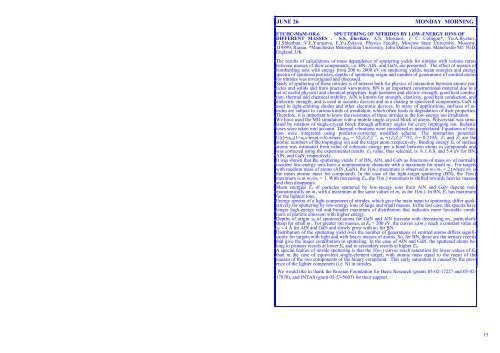Wüest M. 51 Wykes M. 82 Yamaguchi M. 17 Ybarra G. 129 Yubero F ...
Wüest M. 51 Wykes M. 82 Yamaguchi M. 17 Ybarra G. 129 Yubero F ...
Wüest M. 51 Wykes M. 82 Yamaguchi M. 17 Ybarra G. 129 Yubero F ...
Create successful ePaper yourself
Turn your PDF publications into a flip-book with our unique Google optimized e-Paper software.
JUNE 26 MONDAY MORNING<br />
ETCHC-MoM-OR.6 SPUTTERING OF NITRIDES BY LOW-ENERGY IONS OF<br />
DIFFERENT MASSES . S.S. Elovikov, A.S. Mosunov, J. C. Colligon*, Yu.A.Ryzhov,<br />
I.I.Shkarban, V.E.Yurasova, E.Yu.Zykova. Physics Faculty, Moscow State University, Moscow,<br />
119899, Russia. *Manchester Metropolitan University. John Dalton Extension. Manchester M1 5GD,<br />
England, UK<br />
The results of calculations of mass dependence of sputtering yields for nitrides with various ratios<br />
between masses of their components, i.e. BN, AlN, and GaN, are presented. The effect of masses of<br />
bombarding ions with energy from 200 to 2000 eV on sputtering yields, mean energies and energy<br />
spectra of sputtered particles, depths of sputtering origin and number of generations of emitted atoms<br />
for nitrides was investigated and discussed.<br />
Study of sputtering of these nitrides is of interest both for physics of interaction between atomic particles<br />
and solids and from practical viewpoints. BN is an important constructional material due to a<br />
set of useful physical and chemical properties: high hardness and electric strength, good heat conduction,<br />
thermal and chemical stability. AlN is known for strength, elasticity, good heat conduction, and<br />
dielectric strength, and is used in acoustic devices and as a coating in spacecraft components. GaN is<br />
used in light-emitting diodes and other electronic devices. In many of applications, surfaces of nitrides<br />
are subject to various kinds of irradiation, which often leads to degradation of their properties.<br />
Therefore, it is important to know the resistance of these nitrides to the low-energy ion irradiation.<br />
We have used the MD simulation with a mobile single-crystal block of atoms. Polycrystal was simulated<br />
by rotation of single-crystal block through arbitrary angles for every impinging ion. Inelastic<br />
loses were taken into account. Thermal vibrations were considered as uncorrelated. Equations of motion<br />
were integrated using predictor-corrector modified scheme. The interaction potential:<br />
U(r)=a bm (1+a b /r)exp(-r/b),where a bm = 52(Z 1 Z 2 ) 3/4 , a b = (Z 1 Z 2 ) 1/4 /52, b = 0.219Å, Z 1 and Z 2 are the<br />
atomic numbers of the impinging ion and the target atom, respectively. Binding energy E b of surface<br />
atoms was estimated from value of cohesion energy per a bond between atoms in compounds and<br />
was corrected using the experimental results. E b value, thus selected, is: 8.1, 6.8, and 5.4 eV for BN,<br />
AlN, and GaN, respectively.<br />
It was shown that the sputtering yields Y of BN, AlN, and GaN as functions of mass m 1 of normally<br />
incident low-energy ions have a nonmonotonic character with a maximum for small m 1 . For targets<br />
with medium mass of atoms (AlN, GaN), the Y(m 1 ) maximum is observed at m 2 /m 1 = 2 (where m 2 is<br />
the mean atomic mass for compound). In the case of the light-target sputtering (BN), the Y(m 1 )<br />
maximum is at m 2 /m 1 = 1. With increasing E 0 , the Y(m 1 ) maximum is shifted towards heavier masses<br />
and then disappears.<br />
Mean energies Ē 1 of particles sputtered by low-energy ions from AlN and GaN depend nonmonotonically<br />
on m 1 with a maximum at the same values of m 1 as for Y(m 1 ). In BN, Ē 1 has maximum<br />
for the lightest ions.<br />
Energy spectra of a light component of nitrides, which give the main input to sputtering, differ qualitatively<br />
for sputtering by low-energy ions of large and small masses. In the last case, the spectra have<br />
longer high-energy tail and broader maximum of distribution that indicates more favorable conditions<br />
of particle emission with higher energy.<br />
Depths of origin x 0 of sputtered atoms for GaN and AlN increase with decreasing m 1 , particularly<br />
sharp for small m 1 . For greater ion masses, at E 0 = 200 eV, the curves x 0 (m 1 ) reach a constant value at<br />
x 0 ∼ 4 Å for AlN and GaN and slowly grow with m 1 for BN.<br />
Distribution of the sputtering yield over the number of generations of emitted atoms differs significantly<br />
for targets with light and with heavy masses of atoms. So, for BN, these are the tertiary recoils<br />
that give the major contribution to sputtering. In the case of AlN and GaN, the sputtered atoms belong<br />
to primary recoils at lower E 0 and to secondary recoils at higher E 0 .<br />
A special feature of nitride sputtering is that the Y(m 1 ) curves reach saturation for lower values of E 0<br />
than in the case of equivalent single-element target, with atomic mass equal to the mean of the<br />
masses of the two components of the binary compound. This early saturation is caused by the presence<br />
of the lighter component (i.e. N) in nitrides.<br />
We would like to thank the Russian Foundation for Basic Research (grants 05-02-<strong>17</strong>227 and 05-02-<br />
<strong>17</strong>870), and INTAS (grant 03-53-5607) for their support.<br />
15
















